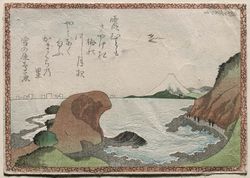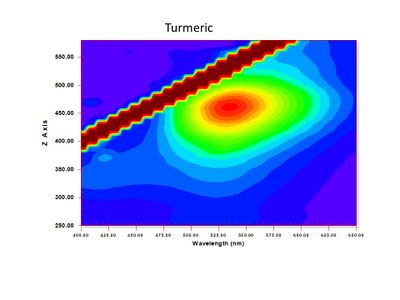Difference between revisions of "Category:Turmeric: Ukiyo-e colorant"
| Line 1: | Line 1: | ||
| − | |||
| − | [[ | + | [[File:SC155045.jpg|right|250px|link=https://collections.mfa.org/objects/207552/kamakura-village-from-an-untitled-series-of-westernstyle-l?ctx=1be86594-d25a-458d-827f-8e5dc3048977&idx=0|Kamakura Village by Katsushika Hokusai]] |
| + | <font size="3">'''[[Turmeric]]'''</font> 藍(''ukon''): A natural yellow or brown dye obtained from the root the ''Curcuma domestica'' (or ''C. longa'') plant native to India and southeast Asia. Turmeric was used in Polynesia as a textile and skin dye. It was known in Mesopotamia and used by the ancient Greeks and Romans. When it was imported to Europe is 1612, it became a popular yellow dye for [[silk]] scarves. The roots are dried then powdered for sale. The primary color component in turmeric is curcumin. It is a water-soluble dye that forms a bright yellow color on [[cotton]] without a [[mordant]]. Darker orange to brown shades are produced with [[alum]], [[ tin]], [[chromium|chrome]], and [[copper]] mordants. [[Iron]] mordants produce a dull green shade. The fugitive colorant was also used to make [[yellow pigments]] and to tint varnishes. Turmeric is currently used as a flavoring agent in curry powder and as a yellow colorant in mustard, cheese, [[paper]], [[wood]], and [[wax]]. | ||
| + | '''For more information see:''' [[Turmeric]] | ||
| + | <br> | ||
| + | |||
| + | == Examples of Turmeric in Ukiyo-e Prints == | ||
| + | |||
| + | {|class="wikitable" style="display: inline-table;font-size:90%;text-align:center;width:15%" | ||
| + | |[[File:dyed indigo.jpg|200px]] | ||
| + | |- | ||
| + | | | ||
| + | [[File:Indigo FORS.JPG|200px]]<br>[[Harunobu, Beautiful Women of the Yoshiwara, Applying makeup (MFA 2006.1537.5)|Beauties of the Yoshiwara by Suzuki Harunobu]] | ||
| + | |} | ||
| + | {| class="wikitable" style="display: inline-table;font-size:90%;text-align:center;width:15%" | ||
| + | |[[File:dyed indigo.jpg|200px]] | ||
| + | |- | ||
| + | | | ||
| + | [[File:Indigo FORS.JPG|200px]]<br>[[Harunobu, Beautiful Women of the Yoshiwara, Applying makeup (MFA 2006.1537.5)|Beauties of the Yoshiwara by Suzuki Harunobu]] | ||
| + | |} | ||
| + | {| class="wikitable" style="display: inline-table;font-size:90%;text-align:center;width:15%" | ||
| + | |[[File:dyed indigo.jpg|200px]] | ||
| + | |- | ||
| + | | | ||
| + | [[File:Indigo FORS.JPG|200px]]<br>[[Harunobu, Beautiful Women of the Yoshiwara, Applying makeup (MFA 2006.1537.5)|Beauties of the Yoshiwara by Suzuki Harunobu]] | ||
| + | |} | ||
| + | {| class="wikitable" style="display: inline-table;font-size:90%;text-align:center;width:15%" | ||
| + | |[[File:dyed indigo.jpg|200px]] | ||
| + | |- | ||
| + | | | ||
| + | [[File:Indigo FORS.JPG|200px]]<br>[[Harunobu, Beautiful Women of the Yoshiwara, Applying makeup (MFA 2006.1537.5)|Beauties of the Yoshiwara by Suzuki Harunobu]] | ||
| + | |} | ||
| + | {| class="wikitable" style="display: inline-table;font-size:90%;text-align:center;width:15%" | ||
| + | |[[File:dyed indigo.jpg|200px]] | ||
| + | |- | ||
| + | | | ||
| + | [[File:Indigo FORS.JPG|200px]]<br>[[Harunobu, Beautiful Women of the Yoshiwara, Applying makeup (MFA 2006.1537.5)|Beauties of the Yoshiwara by Suzuki Harunobu]] | ||
| + | |} | ||
| + | |||
| + | == Analysis == | ||
| + | Fiber optic reflectance spectroscopy (FORS) can easily identify the three blues: indigo, dayflower, and Prussian blue. | ||
| + | <gallery mode=packed heights=200px style="text-align:left"> | ||
| + | Turmeric EEM ref.jpg|3D EEM plot for Turmeric | ||
| + | </gallery> | ||
| + | |||
| + | ==Other Images of Turmeric == | ||
<gallery> | <gallery> | ||
File:13 Turmeric root_detail.jpg|Turmeric ''Ukon'' rhizomes | File:13 Turmeric root_detail.jpg|Turmeric ''Ukon'' rhizomes | ||
| Line 9: | Line 52: | ||
File:turmeric_powder.jpg|Ground turmeric | File:turmeric_powder.jpg|Ground turmeric | ||
File:turmeric.jpg|Turmeric dyed paper | File:turmeric.jpg|Turmeric dyed paper | ||
| − | |||
</gallery> | </gallery> | ||
| − | == | + | ==List of Prints == |
| + | List of prints where indigo was detected | ||
| + | |||
[[Category:Ukiyo-e Print Colorant Database]] | [[Category:Ukiyo-e Print Colorant Database]] | ||
Revision as of 18:55, 13 May 2020
Turmeric 藍(ukon): A natural yellow or brown dye obtained from the root the Curcuma domestica (or C. longa) plant native to India and southeast Asia. Turmeric was used in Polynesia as a textile and skin dye. It was known in Mesopotamia and used by the ancient Greeks and Romans. When it was imported to Europe is 1612, it became a popular yellow dye for Silk scarves. The roots are dried then powdered for sale. The primary color component in turmeric is curcumin. It is a water-soluble dye that forms a bright yellow color on Cotton without a Mordant. Darker orange to brown shades are produced with Alum, Tin, chrome, and Copper mordants. Iron mordants produce a dull green shade. The fugitive colorant was also used to make Yellow pigments and to tint varnishes. Turmeric is currently used as a flavoring agent in curry powder and as a yellow colorant in mustard, cheese, Paper, Wood, and Wax.
For more information see: Turmeric
Examples of Turmeric in Ukiyo-e Prints

|

|

|

|

|
Analysis
Fiber optic reflectance spectroscopy (FORS) can easily identify the three blues: indigo, dayflower, and Prussian blue.
Other Images of Turmeric
List of Prints
List of prints where indigo was detected
Pages in category "Turmeric: Ukiyo-e colorant"
The following 56 pages are in this category, out of 56 total.
E
- Eisen, Early Winter: The Day of the Boar in the Tenth Month, from the series Customs of the Four Seasons and Children at Play, 11.25587
- Eisen, Fujieda: Kichô of the Owariya, from the series A Tôkaidô Board Game of Courtesans: Fifty-three Pairings in the Yoshiwara, 11.17946
- Eisen, Geisha at Night under Plum Blossoms, 11.26691-2
- Eisen, The Song Evening Mist at Asama Peak, on Scrap-paper Fabric with an Itchû-bushi Libretto, from the series A Modern Pine Needle Collection, 11.17878
- Eishi, Shizuka of the Shizutamaya, from the series Beauties of the Yoshiwara as Six Floral Immortals, 21.4917
- Eizan, Kashiku of the Tsuruya, from the series Array of Beauties of the Pleasure Quarters, 11.17716
H
- Harunobu, Beautiful Women of the Yoshiwara, Combing hair (2006.1537.1)
- Harunobu, Parody of the Three Evening Poems: Teika, Jakuren, and Saigyô, 11.19703
- Harunobu, The Eleventh Month, from an untitled series of Twelve Months, 11.20120
- Harunobu, The Tenth Month, from an untitled series of Twelve Months, 11.20124
- Harunobu, Young Man Playing a Shakuhachi, 21.4677
- Harunobu, Young Woman Riding a Turtle (Parody of the Story of Urashima Tarô), 21.4594
- Hiroshige I, Enjoying the Cool of Evening on the Riverbed at Shijô, from the series Famous Views of Kyoto, 06.890
- Hiroshige I, The Yodo River, from the series Famous Views of Kyoto, 11.2111
- Hiroshige I/Hiroshige II, Ueno Yamashita, from the series One Hundred Famous Views of Edo, 11.35842
- Hokusai, Woman, Child, and Man with Kite, from the series A Collection of Dances, 11.16764
K
- Kiyohiro, The Attributes of the Seven Gods of Good Fortune, 11.19089
- Kiyomasu II, Actor Segawa Kikunojô I in Momo Chidori Musume Dôjô-ji, 06.423
- Kiyomasu II, Actors Tamazawa Saijirô as the Courtesan Chidori and Ichimura Manzô as Takigô Tôshichi; Calendar for 1744, 21.5455
- Kiyomasu II, The Arrival of the Elephant, 58.343
- Kiyomitsu I, Actor Ichikawa Danzô III as Adachi Hachirô, 11.19030
- Kiyomitsu I, Actors Segawa Kikunojô II as the Courtesan Katsuragi and Ichimura Uzaemon IX as Nagoya Sanza, 45.832
- Kiyomitsu I, Actors Ôtani Hiroji III as Okabe no Rokuyata and Nakamura Sukegorô II as Inomata no Koheiroku, 46.1409
- Kiyonaga, A Matchmaking Meeting at a Teahouse by a Shrine, 21.5574
- Kiyonaga, Actors Matsumoto Kôshirô IV as Ukita Sakingo and Sawamura Sôjûrô III as the Ghost of Takao, with chanters Tomimoto Itsukidayû and Tomimoto Awatayû, and accompanist Sasaki Ichishirô, 11.13921
- Kiyonaga, Actors Matsumoto Kôshirô IV as Ukita Sakingo and Sawamura Sôjûrô III as the Ghost of Takao, with chanters Tomimoto Itsukidayû and Tomimoto Awatayû, and accompanist Sasaki Ichishirô, 21.5476
- Kiyonaga, Child Prodigy Minamoto no Shigeyuki Executing Calligraphy, 11.13883
- Kiyonaga, The Brine Maidens, from the series Current Manners in Eastern Brocade, 21.5610
- Kiyonaga, Women Visiting Enoshima, 11.21277
- Kunisada, Actor Sawamura Tanosuke II, from the series Actor Rebuses, 11.42324
- Kunisada, Actors Iwai Kumesaburô II as Agemaki (R), Ichikawa Danjûrô VII as Sukeroku (C), and Onoe Kikugorô III as Shinbei (L), 21.7532-4
- Kunisada, Komurasaki of the Kado-Tamaya, kamuro Kochô and Sayuri, from the series Comparison of Beauties of the Pleasure Quarters, 11.20991
- Kunisada, Moon Viewing at Mukôjima, a Triptych, from the series Moon, Snow and Flowers, 11.15216
- Kuniyoshi, (Actor Ichikawa Ebizô V as) Inuyama Dôsetsu, from the series The Lives of Eight Brave and Loyal Dog Heroes, 11.28841
- Kuniyoshi, Drying Board Suggesting Hiyodorigoe, from the series Women in Benkei-checked Fabrics, 11.36363
- Kuniyoshi, Hosokute: Horikoshi Dairyô, from the series Sixty-nine Stations of the Kisokaidô Road, 11.28766
- Kuniyoshi, Ruan Xiaowu, the Short-lived Second Son, from the series One Hundred and Eight Heroes of the Popular Shuihuzhuan, 64.800
- Kuniyoshi, The Ninth Hour: Noon; Woman Playing with Cat, Fishmonger and Dog, from the series Sundial of Modern Tradesmen, 11.15955
S
- Sharaku, Actors Ichikawa Komazô III as Kameya Chûbei and Nakayama Tomisaburô I as Umegawa, 11.16483
- Sharaku, Actors Ichikawa Komazô III as Kameya Chûbei and Nakayama Tomisaburô I as Umegawa, 21.7236
- Shigemasa, Bundle Tied with Straw; Calendar for 1815, 11.20149
- Shigemasa, Perspective Picture of the Sleeping Dragon Plum in the Plum Garden at Kameido, 11.14975
- Shigenobu I, Puppy Playing with a Ball, 21.9257
- Shinsai, Chapters 16–18, from the series The Tale of Genji, 11.21066
- Shunkō, Actors Ichikawa Danjûrô V as Fukurokuju, Iwai Hanshirô IV as Ryûyô Dôji, and Sawamura Sôjûrô III as Shin'yô Dôji, 11.14971
T
- TEST-Utamaro I, Women Overnight Guests, a Triptych, 21.6328-30
- TEST-Utamaro I, Women Overnight Guests, left panel of triptych, 21.6328
- Toyoharu, The Armor-pulling Scene at Wada's Banquet, 11.14725
- Toyokuni, Actor Arashi Kitsusaburô I as the Monkey Trainer Yojirô, in the Horikawa Scene of the Play Oshun and Denbei, 11.30331
- Toyokuni, Woman Under Maple and Ginkgo Leaves, from the series Comparison of Beauties, 11.13642
- Toyonobu, Rain in the Fifth Month, 11.19048
U
- Ukiyo-e
- Utamaro I, Courtesan Asajiu of the Daimonjiya and Nanatsu-ume Sake by Momenya, from the series Aristocrats of Sake Compared to Courtesans of Six Selected Houses, 11.14267
- Utamaro I, The Geisha Ogie Matsuzô, Mine, and Ito, 11.14373
- Utamaro I, The Heron Maiden from series An Array of Dancing Girls of the Present Day, 11.14364






